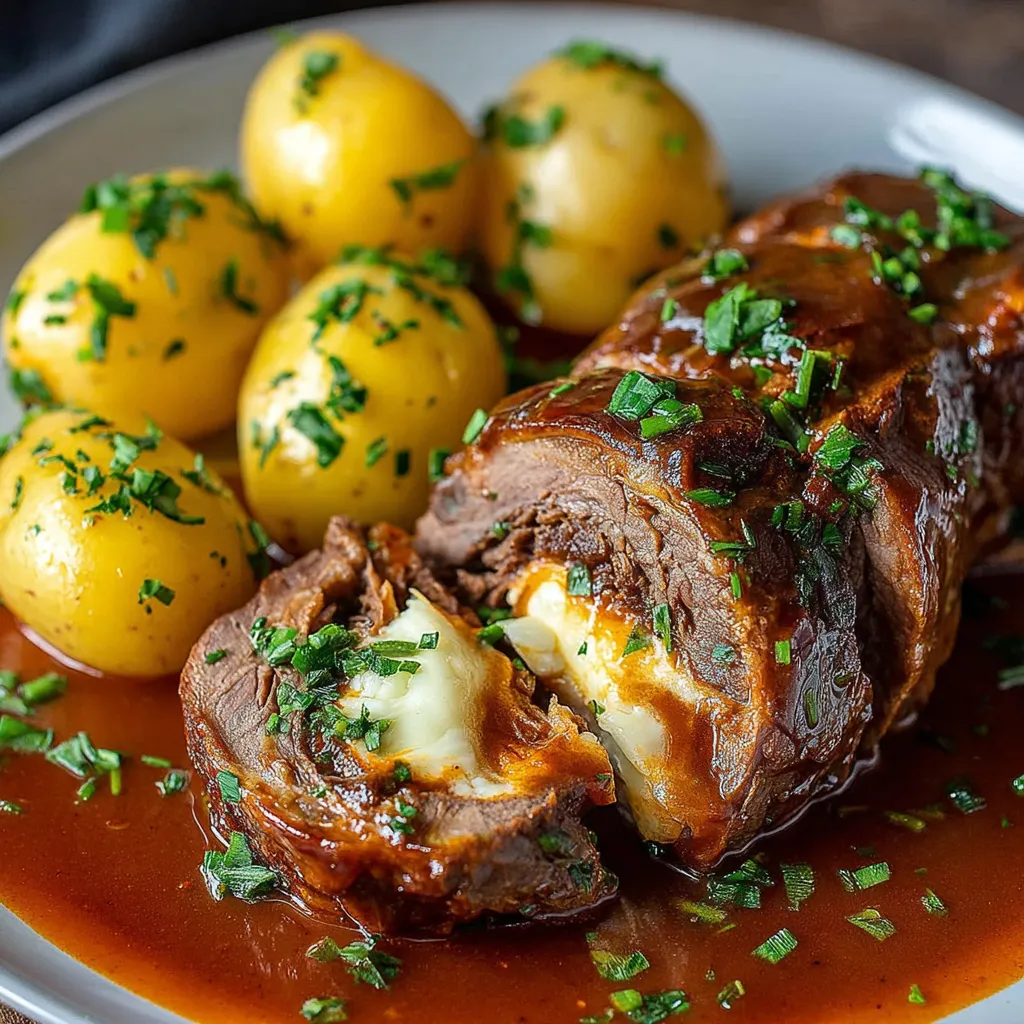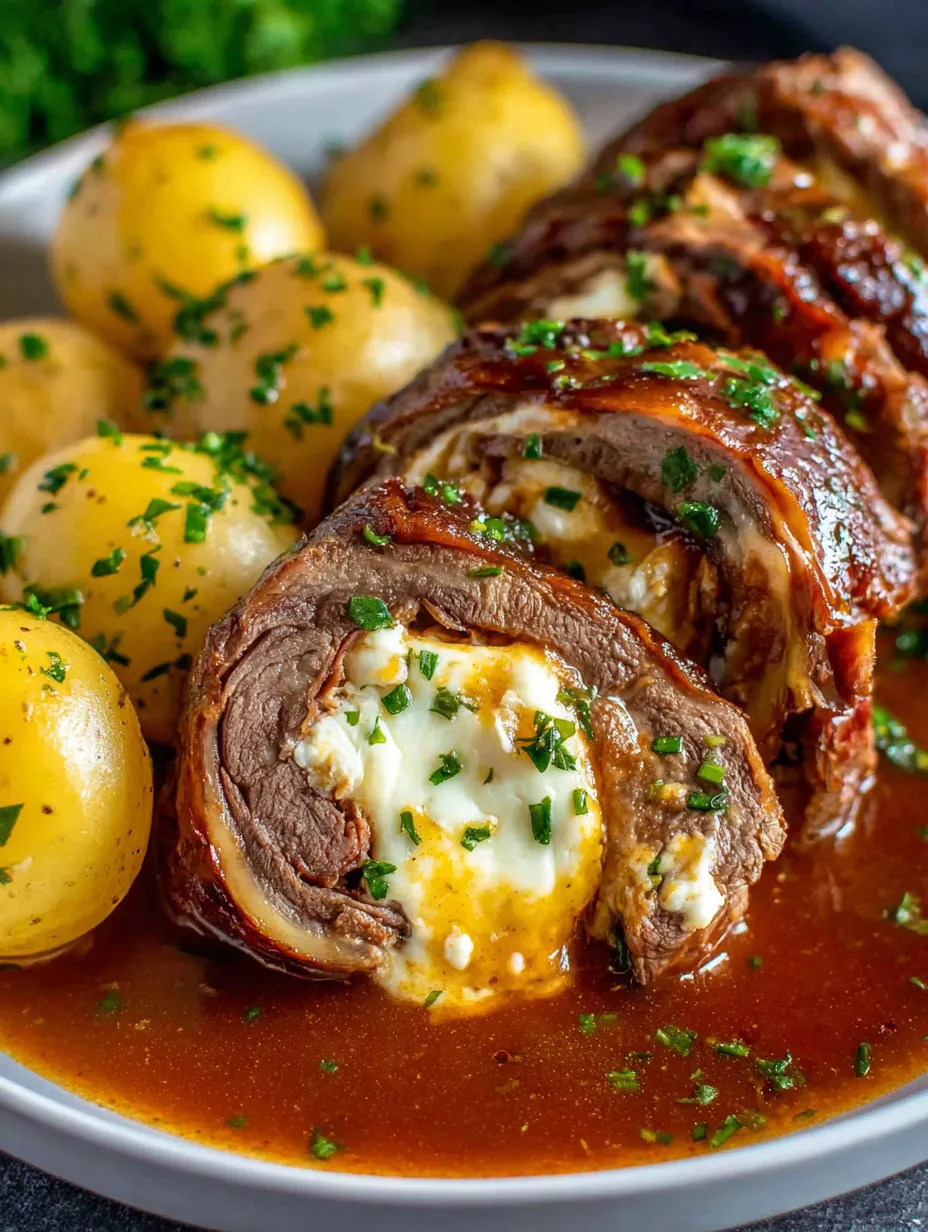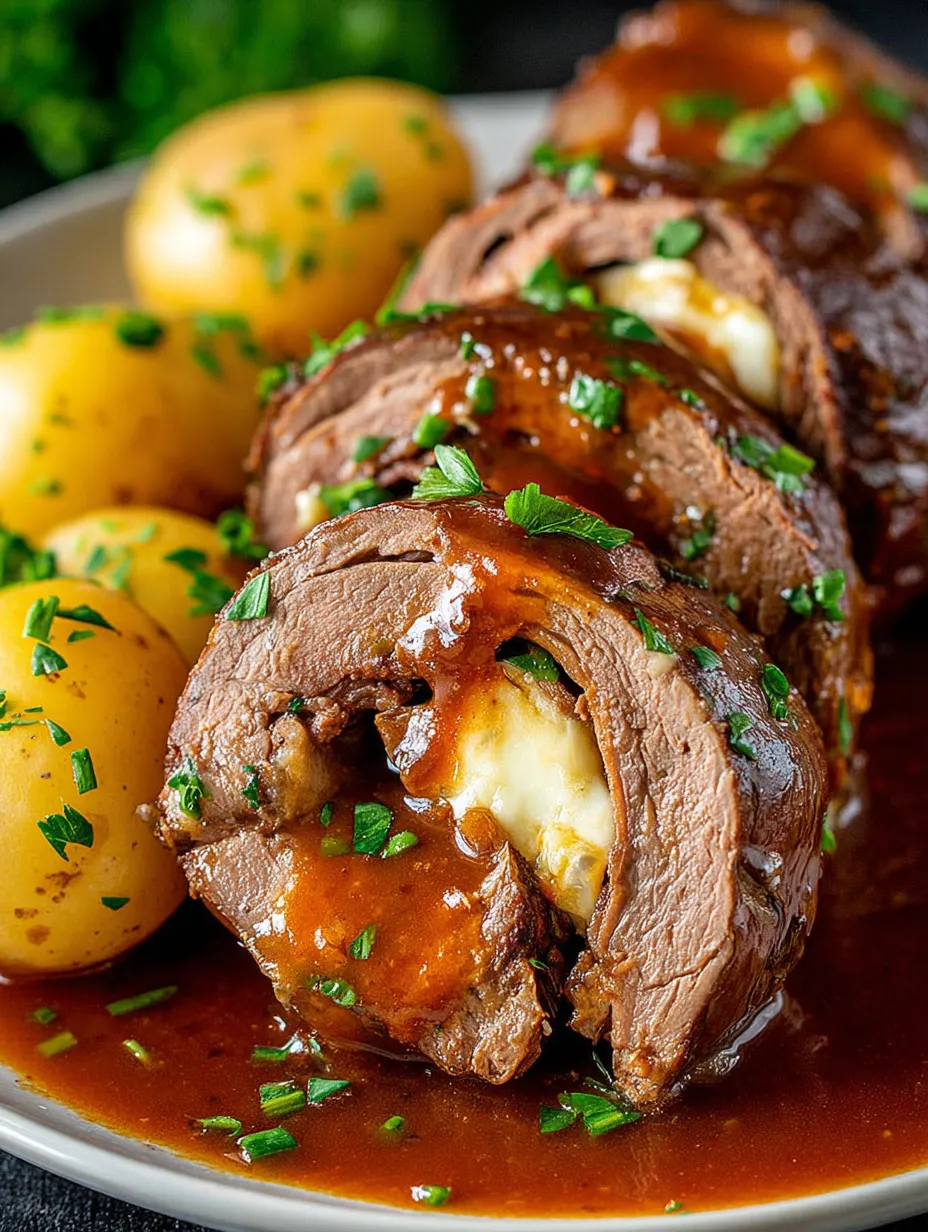 Highlight
Highlight
Classic German beef rolls are all about homey flavors. Thin slices of beef get wrapped around a mix of bacon, mustard, onions, and pickles then slow-cooked until they're tender. These beef rolls are Sunday dinner in Germany—they fill your kitchen with cozy smells and bring everyone to the table.
My family's been crazy about these for as long as I can remember. They're even better after a cold walk outside in winter—totally worth taking your time to let them simmer.
Essential and Standout Ingredients
- Freshly sliced beef (thin): Cooks up juicy after a slow braise. Head to the butcher for the best cuts.
- Hearty bacon: Brings a smoky, salty kick to the filling. Local bacon's always a win.
- Chopped onion: Makes everything moist and adds that sweet flavor.
- German-style mustard: Bring in that nice little tang and a punch to the filling.
- Pickles: Adds bite and a little zing. Go for the classic kind.
- All-purpose flour: Helps crust the rolls while searing, plus thickens the sauce.
- Salt and black pepper: The must-haves that pull it all together.
- Olive oil: For a good sear. Mild virgin oil is my go-to.
- Beef broth: Gives the sauce its real depth. Get some fresh stuff if you can, or use store-bought.
- Dry red wine (optional): Adds extra flavor to the sauce. Pick a bold red from Germany if you can.
- Bay leaves and dried thyme: They mix in that classic slow-cooked flavor.
- Paprika: A dash for color and a subtle lift in taste.
- Butter: For a rich, velvety finish to the sauce.
- Fresh parsley: Chopped on top for a burst of color and flavor. Flat-leaf’s best.
Step-by-Step How-To
- Getting started:
- Put the beef on a board. If it's too thick, cover with plastic wrap and give it a gentle smack with a meat mallet until it’s about 5 mm thick. That way, it rolls up nice and easy.
- Season and spread:
- Sprinkle both sides with plenty of salt and pepper. Smear a thin layer of mustard over each piece—this soaks in the flavor.
- Load up the filling:
- Scatter the bacon and some chopped onion all over. Lay a pickle slice at the wider end—those layers pop in every bite.
- Roll 'em up:
- Starting where the pickle sits, wrap up the beef tight and fold in the sides as you go. Use kitchen twine or toothpicks to keep everything together so nothing falls apart while cooking.
- Coat in flour:
- Toss each roll in a bit of flour and shake off the extra. That thin flour shell gets things crunchy and thickens the sauce later.
- Time to sear:
- Heat olive oil in a big pan. Brown the rolls on all sides over medium-high—you want that golden color. Don't crowd the pan or you'll miss out on all that good browning.
- Cook more onions:
- Pop any extra diced onions in the pot and cook 'em in the leftover fat till they're soft and starting to caramelize. Use a wooden spoon to scrape up the tasty brown bits on the bottom.
- Deglaze things:
- Pour in some wine (or go straight to broth). Let it bubble up so the booze can evaporate. When it’s settled, add the beef broth, then mix in bay, thyme, and paprika.
- Braise:
- Snuggle the beef rolls back into the liquid. They should be mostly covered. Put the lid on and simmer on low for at least 2 hours—peek in now and then and add a splash of broth if it needs it.
- Finish the sauce:
- Take out the rolls and pull out the bay leaves. Let the sauce bubble without a lid to thicken it up. Stir in butter and add any extra seasoning you want. Pour it back over the beef rolls.
- Get ready to eat:
- Take off any string or toothpicks before serving. Slice on an angle if you feel fancy. Spoon on plenty of sauce and finish with fresh parsley.
 Highlight
Highlight
Good to Know
Quality beef is the trick for juicy results
Even better the next day—leftovers reheat like a dream
Super filling and feeds a crowd
Rolling and browning these with my daughter for the first time made it a regular thing at our house. The mix of savory and rich always makes everyone happy. That little bit of tang from the pickle just does it for me.
Storage and Leftovers
Stick the beef rolls in your fridge for up to three days, no problem. The flavor actually gets deeper. To warm up, just heat gently in a pan with a little broth. You can freeze extras too. It’s the best make-ahead meal for Sunday.
Swaps and Changes
If wine's not your thing, use only broth—works just fine. Use mild or strong mustard to suit your taste. No bacon? Swap in smoked breakfast pork. Want to mix it up? Add a little carrot or celery to the filling for a twist.
Classic Sides and Serving Ideas
Kartoffelklöße (potato dumplings), Spätzle, or bread dumplings are all favorites on the side. Red cabbage or apple-red cabbage add some freshness. Mashed potatoes or green beans are great too. Whatever you do, don't skimp on plenty of rich brown sauce.
 Highlight
Highlight
Story Behind Beef Rolls
Beef rolls have been a family favorite in Germany forever. Back in the day, it was a clever way to turn just a bit of beef into a really special meal. That combo of filling, meat, and glossy sauce still means it's top pick for festive dinners.
Recipe FAQs
- → How do I make sure the beef rolls turn out super tender?
If you really pound out the beef and cook them slowly on low heat, they'll come out melt-in-your-mouth good.
- → What can I put inside my beef rolls?
The usual is bacon, onions, mustard, and pickles, but you can switch it up and try other fillings if you feel like it.
- → What goes well on the side?
Mashed potatoes, red cabbage, potato dumplings, or spaetzle all work great and make it a full meal.
- → Can I prep and reheat beef rolls?
Yep, and honestly they taste even better the day after—just warm them up gently when you’re ready to eat.
- → How do I get the sauce really full of flavor?
Sear those rolls first, then simmer everything so the liquid thickens up. That’s how you get a rich, tasty sauce.
- → Does the sauce have to have red wine?
Red wine makes it deeper, but you can skip it and just add more broth if that's what you like.
Beef Rolls with Sauce
Soft beef, tasty stuffing, and a bold sauce will have everyone at the table happy.
Ingredients
→ For serving & finishing touches
→ Liquid & seasoning for sauce
→ Coating & browning
→ Meat and filling
Steps
Take out the toothpicks or string from each roll. Put your rolls on plates. Pour a good amount of the sauce over the top. Toss fresh parsley on for a pop of color. If you want, add on classic sides like spätzle, mashed potatoes, red cabbage, or potato dumplings.
Very gently lift the cooked rolls out and keep them warm. Pull out the bay leaves. Let your sauce bubble on medium so it thickens a bit. Stir in some butter and taste to see if it needs more salt and pepper.
Move the seared rolls back into the pot, mostly under the liquid. Cover up and let them cook gently on low for about 2 to 2 and a half hours till they're super tender. Check the liquid now and then and add extra stock if you have to.
Toss in the beef stock, paprika, thyme, and bay leaves. Give it a good mix.
Pour in the wine if you're using it and let bubble down a bit. If you're skipping wine, just go ahead and add the beef stock right away.
Put the rest of your chopped onions in the same pot and cook, stirring, for 5 to 7 minutes till they're turning golden. Use a wooden spoon to scrape any brown bits off the bottom.
Heat up olive oil in a big heavy pot over medium-high. Brown your rolls on every side so they're deep gold. Don't crowd the pan. Once they're all done, take them out and set aside.
Dump the flour into a shallow dish. Roll each stuffed steak in the flour so it's covered all over then shake off anything that's extra.
Tightly roll the meat up from the end with the pickle. Tuck in the sides. Use string or toothpicks to hold each roll together so nothing falls out.
On top of each meat slice, sprinkle bacon pieces and some chopped onion. Place a pickle spear along the bottom edge.
Sprinkle salt and pepper all over both sides of the meat. Take a spoonful of mustard and slather it on each slice so it's covered.
Lay your beef slices on a cutting board. If they're a bit thick, put them between two layers of plastic wrap and gently pound down to about half a centimeter thick. Be gentle so you don't rip the pieces.
Notes
- If you want super soft rolls, start with good beef. Don't try to rush the cooking time. These are even better the next day since the flavors get stronger overnight.
Required Equipment
- Meat tenderizer
- Cutting board
- Big heavy braiser or Dutch oven
- Kitchen string or toothpicks
- Whisk
Allergen Information
Double-check every ingredient for potential allergens and consult a healthcare professional if unsure.
- Has wheat (gluten), dairy (butter), mustard
Nutritional Information (Per Serving)
This data is for informational purposes only and doesn’t replace medical advice.
- Calories: 520
- Fat: 29 g
- Carbs: 11 g
- Protein: 46 g
